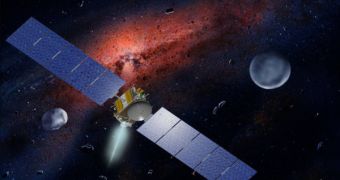Located on an orbit between Mars and Jupiter, the Ceres dwarf planet is about 950 kilometers in diameter, and totals about 32 percent of the mass present in the inner asteroid belt. Astronomers believe that its surface is covered in water ice and various hydrated minerals, and this knowledge has recently sparked an increased interest for a lander mission on the celestial body. Experts have already begun to draw preliminary designs for a Ceres Polar Lander (CPL) mission, which would include a lander and a mini-rover being deployed on one of the planet's poles.
Experts from the Thales Alenia Space (TAS), an European company with extensive experience in constructing satellites and other space infrastructure, say that a future mission to Ceres would take approximately four years to get there, and that it would make use of existing technologies currently employed on Mars. Also, some of the newest technologies, such as those that will be sent to the Moon in the next decade, could also be used for CPL. The TAS Observation and Science Directorate has already worked on very important space projects, including the Huygens probe, CoRoT, ExoMars, Mars Express and Venus Express.
The experts who have recently turned their attention to Ceres are TAS Interplanetary Advanced Projects leader Joel Poncy, and LPG-Nantes researchers Olivier Grasset and Gabriel Tobie. Speaking about the future mission, Poncy is quoted by Space as saying that, “The lander would separate from the carrier, brake, land close to the target site while automatically avoiding boulders and permanent shadows. We would then perform an analysis similar that that of NASA's Mars Phoenix Lander of the surrounding soil and release a mini-rover to explore further. Astrobiological experiments similar to ExoMars can be envisaged.”
“With current knowledge, Ceres should have life's main ingredients: organics and a significant fraction of H2O. The question mark is energy. Although the probability of life on Ceres is lower than on Europa and Enceladus, which are favored by their tidal energy, or on Titan – which has huge quantities of organics – it should not be neglected,” Poncy also added. “Nobody can reasonably expect more than microbial life. A mission there could basically search for water/carbon-based 'life-as-we-know-it.' For more exotic forms, some have floated the idea of clay-based life on Earth as precursor of 'our' life, and there seems to be a lot of clay on Ceres.”

 14 DAY TRIAL //
14 DAY TRIAL //